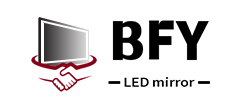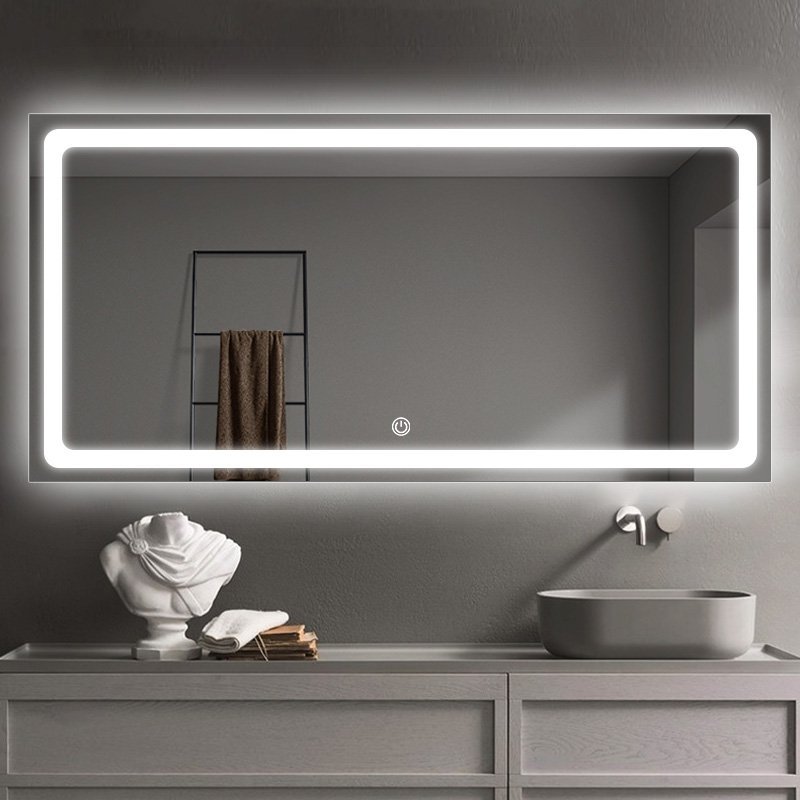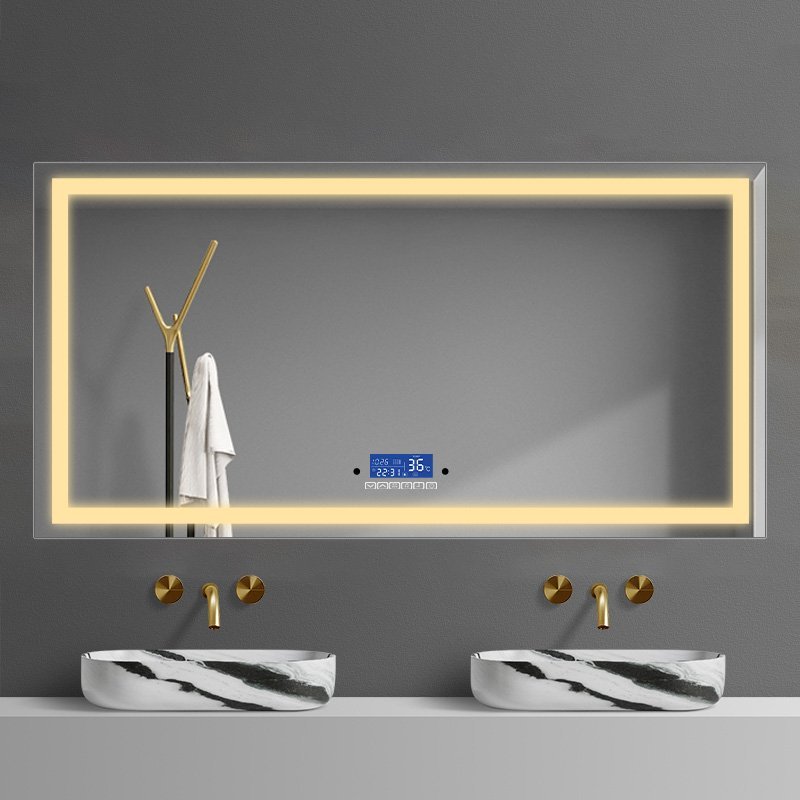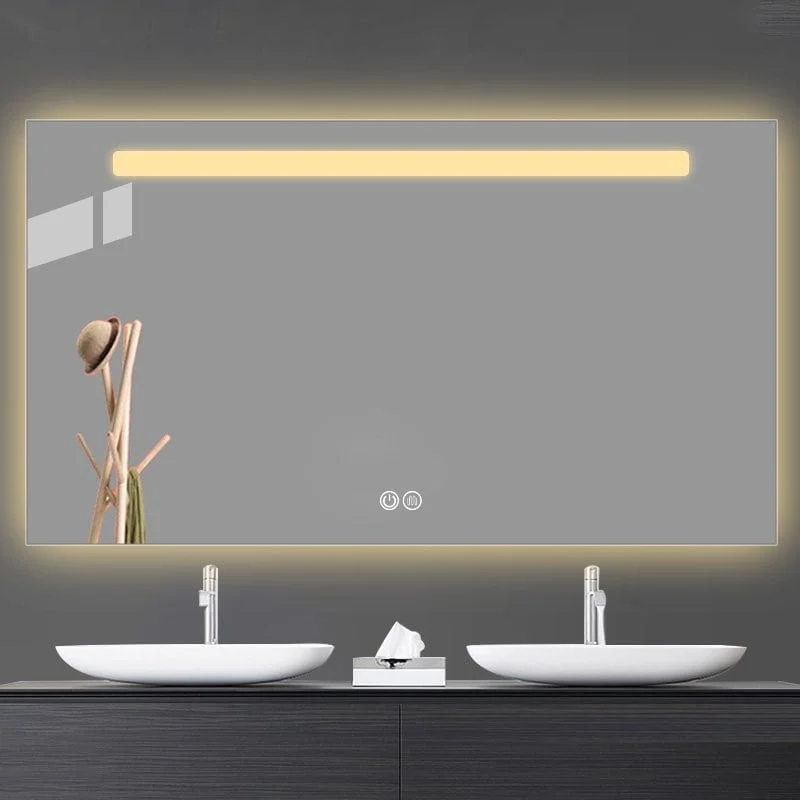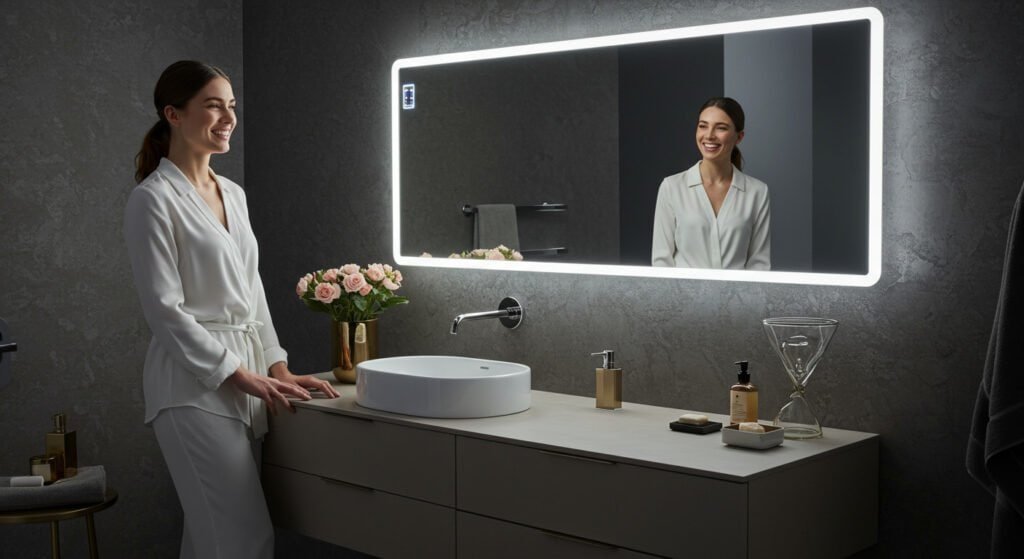|
Getting your Trinity Audio player ready...
|
Improper mirror installation leads to cracked walls, fallen mirrors, and potential injury. How to hang a mirror on the wall?
The key to successful mirror installation involves three essential steps: selecting appropriate mounting hardware based on mirror weight, identifying your wall type accurately, and following proper installation techniques. Quality mirror hanging hooks and mounting systems ensure your led mirror or lighted vanity mirrors remain securely positioned for years.
Understanding these fundamentals will help you achieve professional installation results while protecting both your investment and wall integrity.

What Tools and Hardware Do You Need to Hang a Mirror?
The first key to a successful mirror installation is gathering the correct tools and choosing the proper mounting hardware for your specific type of mirror and the type of wall to which you will be mounting it.
Essential tools include a stud finder, level, drill with appropriate bits, measuring tape, pencil for marking, and safety equipment. For led bathroom mirror installations, you may also need electrical components and wire management systems.
The hardware you will use will vary greatly based on mirror weight and wall type. Lightweight glass mirrors under ten pounds can typically use standard picture hanging wire and wall anchors. However, modern lighted mirrors for bathrooms will typically require heavy-duty mounting brackets, toggle bolts, or lag screws secured into wall studs.
A complete mirror hanging kit should include mounting brackets rated for your mirror’s weight, proper screws or anchors, and installation templates. For larger, rectangular bathroom mirrors with some heft to them, commercial-grade mirror mounting systems distribute the weight across several different anchor points, which prevents stress concentration, which could damage drywall or create failures.
How to Identify Your Wall Type Before Installation?
Mirror and wall construction will guide your mounting approach and hardware selection for bathroom vanity mirrors or led light mirror vanity installs.
Drywall represents the most common interior wall type, identifiable by hollow sounds when tapped and requiring special anchors for secure mounting. Plaster walls produce solid sounds and offer excellent holding power with appropriate screws. Masonry walls including brick or concrete provide maximum support but require specialized drill bits and masonry anchors.
Most modern homes have drywall construction over wood or metal studs that are spaced sixteen or twenty-four inches apart. For heavy installations like backlit mirror systems, you want to mount directly into the studs. Electronic stud finders are the best at detecting the framing members behind the drywall. Magnetic stud finders could cause a problem with led mirrors because of their electronic components.
During lighted makeup mirror installations where you have electrical connections to consider, your understanding of wall construction is also crucial to plan how to run the wires properly and make sure everything is up to code. Older homes might have plaster walls over wooden lath. This type of wall actually holds and anchors incredibly well, but you have to be careful drilling into it. You don’t want to cause those old lath and plaster walls to start cracking and degrading around your mounting points.
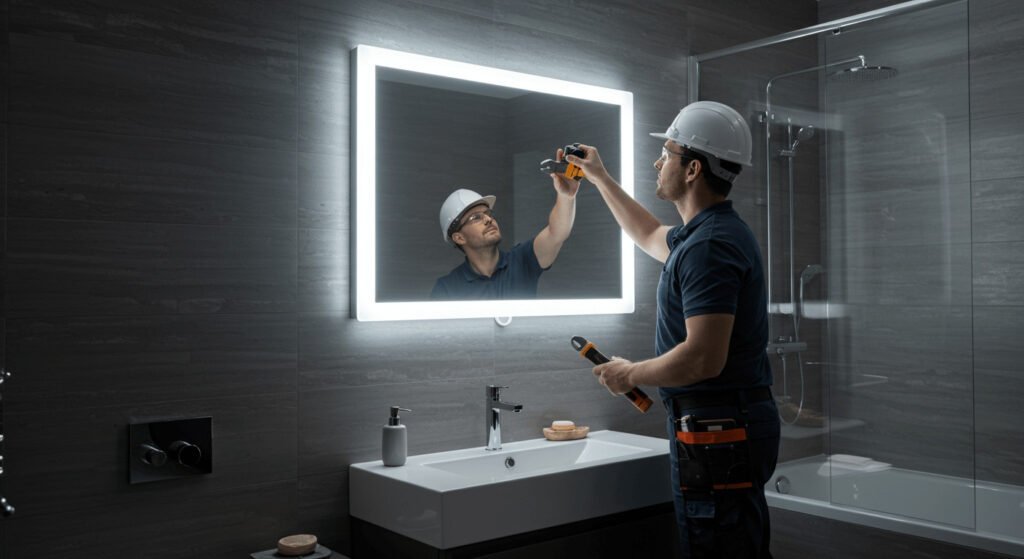
How to Hang Heavy Objects on Wall Securely?
Heavy mirror installs require special techniques and mounting hardware to ensure they don’t fail and that your wall mirror with lights or large bathroom mirror stays put for the long term.
Weight distribution represents the fundamental principle for hanging heavy objects successfully. Single-point mounting concentrates stress and increases failure risk, while multi-point systems spread loads across larger areas. Toggle bolts and molly bolts provide excellent holding power in drywall when studs are unavailable.
When you’re hanging a heavy mirror on drywall, the process can get a bit more complicated. You need to make sure your measurements are precise and that you select the right anchors. Heavy-duty toggle bolts, for example, can hold up to seventy-five pounds per anchor when installed correctly. They can be a great option for most lighted vanity mirrors for bathroom uses.
But again, if you get over fifty pounds, you really want to try to hit those wall studs, either with lag screws or through-bolts if at all possible. In professional installations, particularly on led bathroom mirror systems where you have electrical tied in, what a lot of your professional installers will do as a redundant system is to combine different types of mounts. They might have something that mounts to the stud and then they have an intermediate anchor in there in case that didn’t hold, but that’s typically for heavier applications.
How to Hang a Heavy Mirror or Picture Without Damage?
When hanging large mirrors, you have to be thinking ahead and planning ahead to ensure you don’t rip your wall down, so to speak, but you’re still getting a secure mount, particularly when dealing with your modern bathroom mirror or a vanity mirror with led lights.
Protection techniques include using mounting templates, pre-drilling pilot holes, and selecting appropriate anchor sizes to prevent over-expansion in drywall. Professional installation methods minimize wall stress and provide clean, finished appearances.
The key is to accurately measure everything out and get the mounting points marked. If you have a mirror with black frame, or a mirror that is considerably heavy, something you can do is cut out paper templates the size of the mounting bracket to help you make sure that these things are exactly where you want them and that you’re not drilling a bunch of holes in your wall in the wrong place. Use a little bit of painters tape to tape them up and use them as a guide where you’re going to be drilling. That way you cover up any of your pencil marks, and you protect your wall a little bit as you drill into it.
With lighted vanity mirrors and any type of makeup mirror with lights, these are usually mounted somewhere close to a sink or in a bathroom. Keep in mind that you have rough-in for electrical that has to coordinate with this stuff. When you are drilling into the wall, be sure to choose the correct drill bit for the material that you’re drilling into. You’ve got masonry bits for the concrete or the brick that go into the wall, wood bits if you’re mounting it into the studs and then the appropriate size bits for your hollow wall anchors.
You want to make sure that you get the right size bit for your hollow wall anchor and not remove too much material. That’s going to reduce the overall capacity of that anchor in that particular hole. The last tip I have for you is to support these heavy mirrors during installation. Use a temporary brace of some sort, or use a helper. Especially when you’re getting to that final position, and you’re trying to fine-tune everything, lift and twist a heavy mirror, your bolts and screws in these anchors can only hold to a point. You definitely don’t want to exceed that. When you do, things fail.
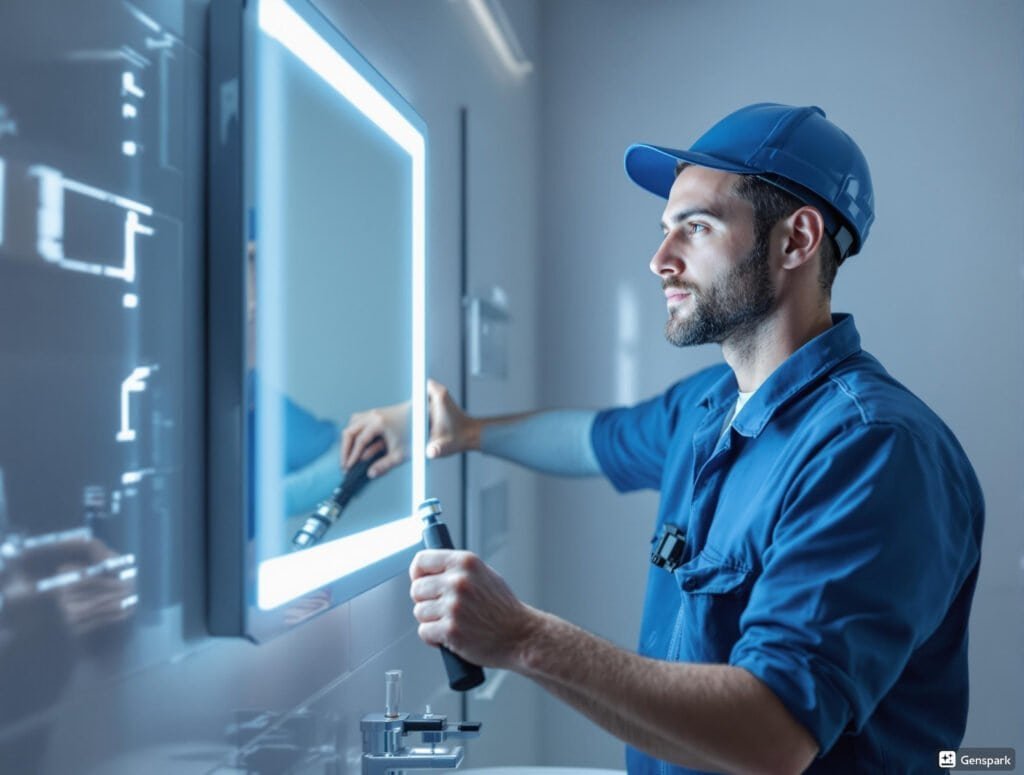
How Do You Hang a 50 Pound Mirror on Drywall?
If you get over fifty pounds, you absolutely need to mount to your wall studs using lag screws or through-bolts if possible.
Heavy-duty toggle bolts rated for seventy-five pounds or more provide adequate support when properly installed. Four mounting points distribute weight effectively and provide redundant security for your bathroom light mirror or substantial backlit mirror installation.
For installing heavy mirrors, the first step in the process is to determine where your studs are using an electronic stud finder. This is key because mounting heavy objects onto your wall is much better all around if you can hit a stud due to the added support it can provide. With electronic stud finders, they are designed to look for a change in the density or the makeup of the wall you are scanning.
For a lighted vanity mirror or simply a vanity mirror, you may need to scan for a stud that can support the mirror as well as any additional pressure created when you’re tugging on the mounting brackets. When you do mount the mirror, it’s recommended to always have the brackets load bearing, not just the mirror hanging off the wall. Anyway, if you’ve been struggling to locate the studs in your house, this is the ideal opportunity to use an electronic stud finder rather than a magnetic one when dealing with LED mirrors or modern vanity mirrors.
The mounting pattern that’s being used should distribute the weight across multiple anchors. A lot of times that means that you’ve got four anchors going into the wall, and they’re in a rectangular pattern to match your mounting hardware on the back of the mirror. But if you’ve got an led mirror that’s got electrical involved—meaning you’ve got a wire coming down and it’s going to go through the wall—you definitely want to coordinate the mount, the mirror install, with your electrical rough-in, this way you can take and hide your wire in the wall and not have to worry about violating any electrical code. Here’s a pro tip for you. When we’re doing these large modern mirror installations, we actually use a little bit of a temporary support system. We use that to hold the mirror up and then adjust everything to make sure it’s just positioning just right and also, when you’ve got to do these
Are Command Strips Strong Enough to Hold a Mirror?
For small, lightweight mirrors that don’t have any inlet led lighting and that sort of thing in it, they make command strips that actually work very well. Honestly, for most lighted mirror installation or an led bathroom mirror, these type of fasteners just aren’t going to cut it.
Standard command strips support up to sixteen pounds when properly applied to clean, smooth surfaces. Heavy-duty versions can handle up to thirty pounds, making them viable for small glass mirror applications but inadequate for modern lighted mirrors for bathrooms.
How good is this adhesive once it’s adhered to your wall or something of that nature? When you put it on a smooth, clean surface and apply a lot of pressure to it that’s even and consistent across the adhesive contact points of your tabs, they can hold quite a bit of weight. They can handle the rated amount of weight, but depending on your situation they may not hold the total amount of weight that they say, for example, a command strip that holds up to five pounds. These command strips work well on painted drywall, cleanly glazed tile, or smooth finished wood. They don’t work well on textured walls or where there’s some type of a porous surface. For installation of a light up vanity mirror or a simple vanity mirror under fifteen pounds, command strips could be the route you want to go, especially if you’re renting.
This adhesive mounting is not going to hold a valuable mirror, and it’s not going to hold a heavy mirror. Any mirror that could cause an injury or great deal of property damage when it fell down, professionals are just never going to mount that with adhesive fastening from Command Strips or anything like that. With the weight of the mirror and the humidity in the bathroom, there’s not another choice. Mechanical mounting is the mounting method to use whether you’re hanging a mirror you bought back in 1920 or you’re installing a light up makeup mirror in your bathroom.

How Can I Stick a Mirror to a Wall Without Drilling?
They’ve created quite a few different no-drill, non-penetrating the wall type of fasteners or brackets. However, if you’re looking to have a real simple solution for a light up makeup mirror, then you can use a friction bracket with a tightening screw to hold the actual mirror itself.
Adhesive mounting systems, heavy-duty command strips, and specialized mirror mounting tapes provide drilling-free alternatives for lightweight applications. However, weight and environmental limitations restrict their use with most modern bathroom mirror installations.
They do have mirror mounting tape which is made specifically for glass applications. It adheres much better than a typical double sided tape is going to. It’s supposed to be able to hold up to twenty pounds when used correctly. The actual area where you’re applying this tape needs to be perfectly clean, dry, and smooth. This is after you’ve cleaned it with glass cleaner or something else to get all the grease, dirt, and debris off the surface. Once that’s done, I’ll be able to apply this glass mounting tape or this mirror mounting tape to the back of my mirror wherever I need to put it. For people in a rental situation with a rectangular mirror though, the clips or pressure fitting can be a great temporary solution for you.
But again, with the weight and with it being in a bathroom situation with the humidity and the potential consequences of a failure, which would be the mirror falling down, just make sure you don’t use Command Strips or these adhesives to hang a critical mirror. When you get to something over 50 pounds, you have to drill and mechanically mount that mirror to the wall.
How to Hang a Mirror on a Wall Without Nails?
These methods can include using picture hanging wire and D-rings, mounting brackets or cleats, or a french cleat system. All of these options provide a secure and stable way to hang your wall mirror with lights without using nails.
Professional mounting systems rely on screws and anchors rather than nails, providing increased holding power and reduced risk of failure. Modern mirror hanging kit components are specifically designed for screw mounting applications.
Screw mounting has several advantages over nailing. First, it holds more securely. Also, you have more precise control over where the weight of the mirror goes, and there’s less risk of damaging the wall. There are numerous screw-based mounting options including toggle bolts, molly bolts, butterfly anchors, and drywall anchors. Use these options when mounting a backlit mirror because you’ll be making electrical connections. Screws will give you the security you need for a safe, permanent installation. Choose the right type of anchor (or toggle) for wall construction and mirror weight and follow the manufacturer’s instructions for hole size and minimum depth.
Heavy-duty mounting brackets designed for modern bathroom mirror applications typically feature multiple screw mounting points that distribute loads across larger wall areas. This approach proves particularly important for mirrors with black frame construction or substantial weight where nail mounting would be inadequate. Professional installations consistently favor screw mounting over nail systems due to superior reliability and reduced maintenance requirements over time.

How to Hang a Mirror Without a Frame?
Frameless mirror installations require specialized mounting techniques that secure the glass directly while maintaining clean, modern aesthetics for your led mirror or contemporary bathroom design.
Frameless mounting systems utilize clips, channels, or adhesive methods that secure mirror edges without visible hardware. Professional installations often combine multiple mounting approaches for redundant security and optimal appearance.
Frameless mirror mounting presents unique challenges because the glass edge must support the entire mirror weight without the structural reinforcement provided by traditional frames. Mirror clips provide discrete mounting points along the mirror perimeter, typically positioning at corners and intermediate locations for larger installations. These clips must be precisely positioned to avoid stress concentrations that could crack the glass. For small bathroom mirror applications, specialized mounting channels can support the bottom edge while top clips prevent forward tilting.
The installation sequence requires careful measurement and level positioning of all mounting points before mirror placement. Heavy or large frameless mirrors may require professional installation due to handling difficulties and precise positioning requirements. Led mirrors without frames often incorporate mounting points integrated into the back panel, simplifying installation while maintaining the clean aesthetic. However, these integrated systems typically require specific mounting hardware provided by the manufacturer to ensure proper support and electrical connections where applicable.
How High to Hang Full Length Mirror for Optimal Use?
Full-length mirror positioning requires consideration of user height, room layout, and viewing angles to ensure optimal functionality for your room mirror ideas and daily use requirements.
Standard installation height positions the mirror bottom six to twelve inches above floor level, allowing full-body viewing for users of varying heights. The top should extend at least six feet from the floor for average-height individuals.
Proper height calculation considers the primary users and intended viewing distance from the mirror surface. For lighted vanity mirrors for bathroom installations, positioning should accommodate both standing and seated use if applicable. The mirror should extend from approximately six inches above the floor to at least seventy-two inches high for comprehensive full-body viewing. However, ceiling height and room proportions may require adjustments to maintain visual balance. In bedrooms, full-length mirrors often mount on closet doors or adjacent walls where users have adequate space for viewing and dressing activities.
The horizontal positioning should provide at least eighteen inches of clear space in front of the mirror for comfortable use. For modern lighted mirrors for bathrooms serving dual purposes, coordinate height with other bathroom fixtures to maintain consistent design elements while ensuring functional viewing angles. Professional installations consider lighting conditions and room traffic patterns to optimize mirror placement for both practical use and aesthetic integration with existing room mirror ideas and design themes.

Conclusion
Successful mirror installation requires matching appropriate mounting hardware to mirror weight and wall construction while following proper installation techniques. Professional results depend on careful planning, quality materials, and attention to safety requirements for long-lasting, secure installations.
- To learn how to pick the right bathroom mirror click here.
- To learn how to install a mirror choose here.
- To learn how to pick the right size mirror click here.
- To learn how mirrors are made click here.
- Click here and you will learn why we look better in mirrors.
- Click here you will learn about the TOP 10 led mirror manufacturers for 2024.
- Click here to find out Why doesn’t my vanity mirror light come on?
- Find out How Tall Should Bathroom Mirror Be?Click Here
- Click here if you don’t know how to clean your mirror
- To find out how to fix Touch Sensor Mirror Not Working click here
